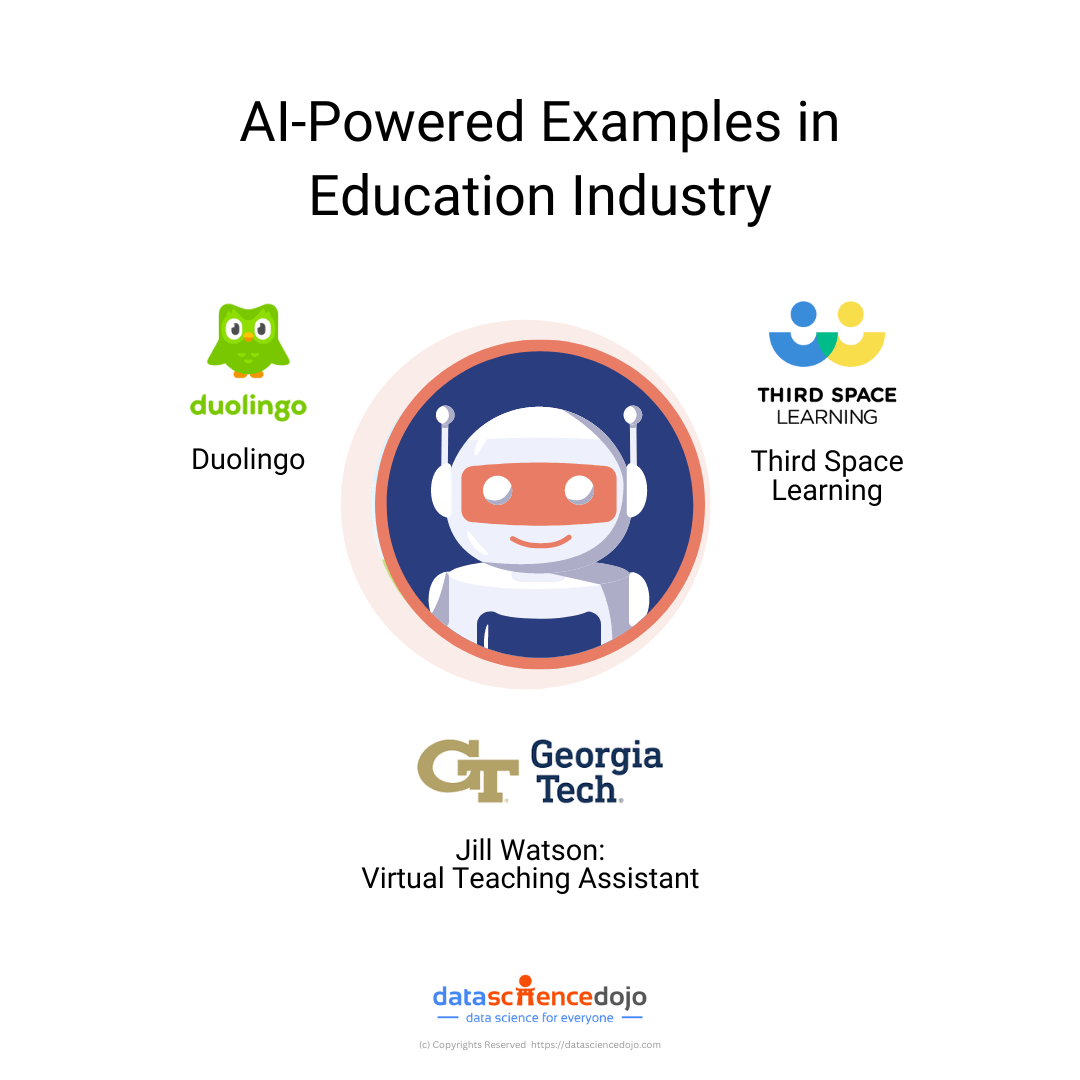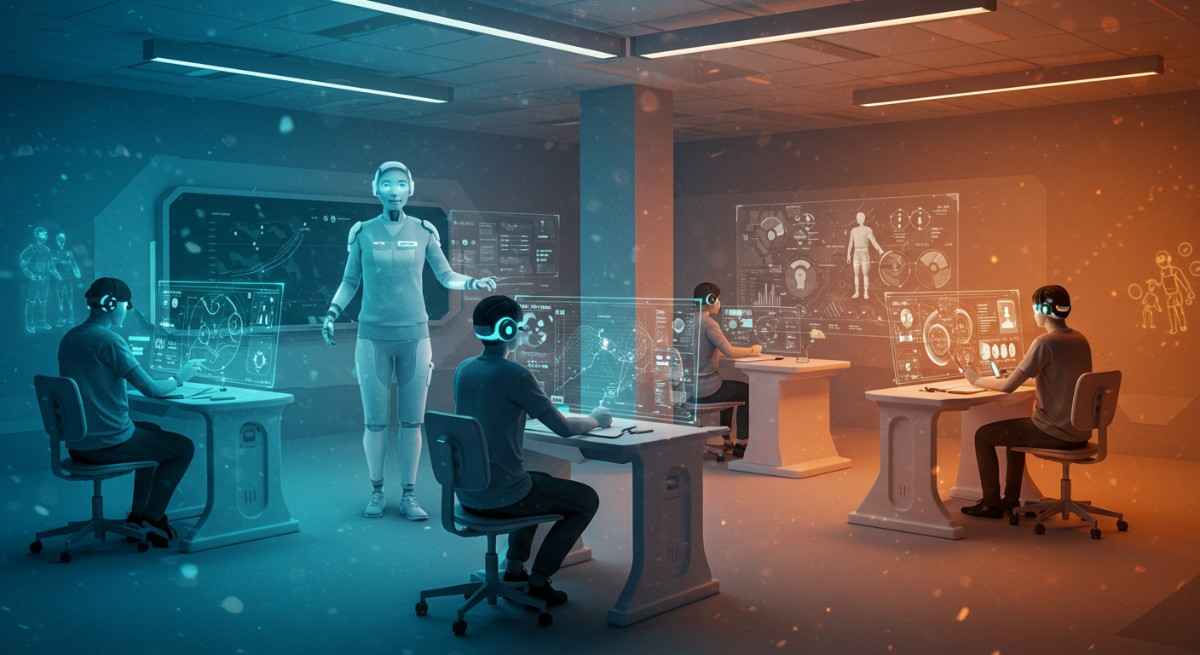Explore three real-life examples to see what types of AI are transforming the education industry and how.
This article is neither a philosophical essay on the role of Artificial Intelligence in the contemporary world nor a horror description that Artificial Intelligence will soon replace us all. Here, we analyze real-life examples from the education industry to see the different types of artificial intelligence in action and evaluate the effect of adopting Artificial Intelligence in education.
Examples from an AI-powered education industry
Learning is an important aspect of life. It is crucial to develop the education industry with advanced technological tools to facilitate all stakeholders. Let’s take a look at three real-life examples that assist students and teachers within the education industry.

Jill Watson – A virtual teaching assistant (AI)
While delivering a massive open online course, the Georgia Institute of Technology found it challenging to provide high-quality learning assistance to the course students. With about 500 students enrolled, a teaching assistant wasn’t able to answer the heaps of messages that the students sent.
Without personalized assistance, many students soon lost the feeling of involvement and dropped out of the course. To provide personal attention at scale and prevent students from dropping out, Georgia Tech decided to introduce a virtual teaching assistant, a step towards revamping the education industry.
Jill Watson (that’s the assistant’s name) is a chatbot intended to reply to a variety of predictable questions (for example, about the formatting of the assignments and the possibility of resubmitting the assignments). Jill was trained on a comprehensive database consisting of the student’s questions about the course, introduction emails, and the corresponding answers that the teaching staff had provided.
Initially, the relevance of Jill’s answers was checked by a human. Soon, Jill started to automatically reply to the students’ introductions and repeated questions without any backup. When Jill receives a message, ‘she’ maps it to the relevant question-answer pair from the training database and retrieves an associated answer.
AI type used: Being a chatbot, Jill represents interactive AI – ‘she’ automates communication without compromising on interactivity.
Third space learning using AI- An online learning platform
While giving one-to-one math lessons to 3,500 pupils weekly, Third Space Learning was looking to improve the learners’ engagement and identify best practices in teaching.
To achieve that, they have applied Artificial Intelligence to analyze the recorded lessons and identify the patterns in the teachers’ and pupils’ behavior. For example, it can identify if a pupil is showing signs that correspond to the ‘losing interest’ pattern.
In the future plans for the education industry, Third Space Learning plans to provide its tutors with real-time AI-powered feedback during each lesson. For example, if a tutor talks too fast, Artificial intelligence will advise them to slow down.
Third Space Learning’s AI (with both its current and future functionality) looks exactly like analytic AI, which is focused on revealing patterns in data and producing recommendations based on the findings. It aims to create a progressive education industry with empowered teachers.
Duolingo – A language-learning platform
Among the three use cases that we are considering within the education industry, Duolingo appears to be an absolute champion in terms of the number of challenges solved with its help.
For example, when many users felt so discouraged from being offered too simple learning materials that they dropped out of the course immediately, Duolingo introduced an AI-powered placement test. Being computer-adaptive, the test adjusts the questions to the previously given answers, generating a simpler question if a user made a mistake and a more complex question if the user answered correctly. The complexity of the words and the grammar used also influence the test configuration.
Besides, Duolingo uses Artificial Intelligence to optimize and personalize lessons. For that, they have developed a ‘half-life regression model’, which analyzes the error patterns that millions of language learners make while practicing newly learned words, to predict how soon a user will forget a word. The model also takes into account words’ complexity.
These insights allow identifying the right time when a user should practice the word. Duolingo says that they have seen a 12% boost in user engagement after putting the model in production.
With the same purpose of boosting user engagement, Duolingo tried bots to help learners practice the language. Available 24/7, the bots readily communicated with the users, as well as shared their feedback on a better version of the user’s answer.
Besides, the bots contained a ‘Help me reply’ button for those who experienced difficulties with finding the right word or applying the right grammar rule. Though currently unavailable, the bots will reappear (at least the official message from Duolingo’s help center leaves no doubt about this).
Artificial Intelligence type used: Analytic AI (the placement test and the prediction model), interactive (bots).
Two Sentences – Long findings
The examples we considered show that it positively affects the education industry, allowing its adopters to solve such challenges as bringing personal attention at scale, improving students’ performance and engagement, identifying teaching best practices, and reducing teachers’ workload. And as we see, to solve these challenges, the industry players resort to analytic and interactive AI.


